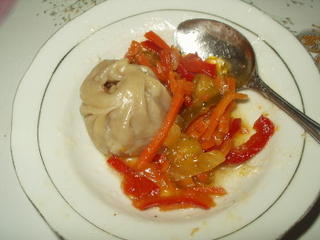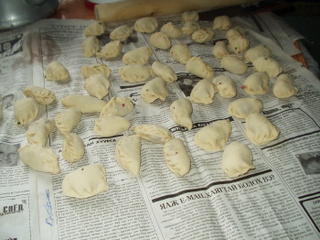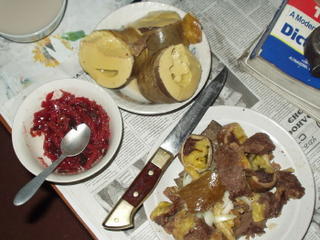Wednesday, July 27, 2005
A little more about food
Having grown up in California, I love fruit and vegetables. In my town in Mongolia, I can buy potatoes, carrots, turnips, beets, cabbage, onions, garlic, and, on occasion, tomatoes and cucumbers. Apples can be bought year-round and at three or four points in the year I can get kiwis, bananas, grapes, mandarins and nectarines. I would say, that aside from my family, and from basic lifestyle changes, the thing I miss the most is variety in food. If I decide that I want a lettuce salad, I'm out of luck. If I decide that I want Mexican food, I have to make it with whatever resources I can find. It is a challenge, but it can also be fun. Living in Mongolia has done wonders for my cooking skills!
Food
The two main ingredients of food in Mongolia are meat and dough. There is an abundance of meat in Mongolia, although in recent years the price has been increasing. The type of meat that you can buy varies from place to place. In my town we can buy beef, mutton (sheep meat), some goat, and horse. In some parts of Mongolia you can buy camel and yak meat, too. The dough is simply made from flour and water. A variety of Mongolian foods are made with meat and dough (and occasional other ingredients).

Buuz, the kind of dumpling shown above (with a pickled salad), are made of meat, fat, onion, a little salt, and a little water wrapped in dough and then steamed.

Bansh, above, contain the same ingredients as buuz, but they are smaller and are pinched differently. Bansh are generally cooked in soup.
If you used the same ingredients again but made the dumpling flatter (sort of like a quesadilla) and fried it, it would be called huushuur. If you cut up the dough like fat noodles and stirfried some meat and root vegetables (carrots, turnips, potatoes) and then cooked it all together, it would be called Tsuivan. Tsuivan is my absolute favorite Mongolian food and is best when topped with a slightly spicy Russian ketchup.
Mongolians also eat a lot of soup, although, I should warn you that even vegetable soup in Mongolia must contain meat or it wouldn't be considered a real meal. Rice stirfried with meat and some root veggies is also a common meal.

Some of the different ethnic groups in Mongolia have different foods as well. One of my friends, who is a Buriat, served me this meal of horse intestines, white blood sausage, and beet salad.

Buuz, the kind of dumpling shown above (with a pickled salad), are made of meat, fat, onion, a little salt, and a little water wrapped in dough and then steamed.

Bansh, above, contain the same ingredients as buuz, but they are smaller and are pinched differently. Bansh are generally cooked in soup.
If you used the same ingredients again but made the dumpling flatter (sort of like a quesadilla) and fried it, it would be called huushuur. If you cut up the dough like fat noodles and stirfried some meat and root vegetables (carrots, turnips, potatoes) and then cooked it all together, it would be called Tsuivan. Tsuivan is my absolute favorite Mongolian food and is best when topped with a slightly spicy Russian ketchup.
Mongolians also eat a lot of soup, although, I should warn you that even vegetable soup in Mongolia must contain meat or it wouldn't be considered a real meal. Rice stirfried with meat and some root veggies is also a common meal.

Some of the different ethnic groups in Mongolia have different foods as well. One of my friends, who is a Buriat, served me this meal of horse intestines, white blood sausage, and beet salad.
Monday, July 18, 2005
A little help please...
I need a bit of help thinking of what sorts of questions to answer in my FAQ series. If there is anything you would like to know, please post a comment and tell me. It would make my life easier.
FAQs 1
1. Where is Mongolia?
Mongolia is a Central Asian country located north of China and south of Russia. It is a land-locked country and so has no true oceans. However, in Mongolian, the word used for "large lake" is often the same as the word for "ocean". Another free fact: several of the lakes in Mongolia are salt-water lakes.
2. What language do they speak?
Mongolians generally speak Mongolian. It is nothing like Chinese or Russian; in fact it is actually related to Turkish, Kazakh, and possibly Korean. Until the last century, Mongolians used a script borrowed from the Uighurs. Currently the Cyrillic alphabet is used.
3. Are you fluent?
This question still, after four years, sends me into a fit of giggles. Mongolian is not an easy language to learn, in part because it is unlike any other language I've ever tried to learn. Can I communicate? Yes, of course, but there is still so much vocabulary and grammar to be learned! Even people who have studied Mongolian for ten years feel like their language skills need a lot of improvement.
Mongolia is a Central Asian country located north of China and south of Russia. It is a land-locked country and so has no true oceans. However, in Mongolian, the word used for "large lake" is often the same as the word for "ocean". Another free fact: several of the lakes in Mongolia are salt-water lakes.
2. What language do they speak?
Mongolians generally speak Mongolian. It is nothing like Chinese or Russian; in fact it is actually related to Turkish, Kazakh, and possibly Korean. Until the last century, Mongolians used a script borrowed from the Uighurs. Currently the Cyrillic alphabet is used.
3. Are you fluent?
This question still, after four years, sends me into a fit of giggles. Mongolian is not an easy language to learn, in part because it is unlike any other language I've ever tried to learn. Can I communicate? Yes, of course, but there is still so much vocabulary and grammar to be learned! Even people who have studied Mongolian for ten years feel like their language skills need a lot of improvement.
Tuesday, July 05, 2005
How to ask questions
When people learn that I work in Mongolia, they generally are curious. Unfortunately, the questions that come out of their mouths are so broad that I stutter and stumble and end up at a loss for words. Questions such as, "What is it like there?", "So, is it really different?" and "So, tell me about Mongolia." terrify me. I do much better with more specific questions. What's the food like? What's the weather like? What does it look like? What are the people like? What is the exchange rate? By asking the more detailed questions, you ultimately will get your broad questions answered, and with a lot less confusion on my part. When I do try to tackle the broad questions, I never know if the person asking wants the one sentence answer, the five-minute answer, or the two-hour speech; more specific questions alleviate this issue.
I'll be answering a series of frequently asked questions in upcoming posts. If I don't happen to touch on a subject that you are curious about, please ask!
I'll be answering a series of frequently asked questions in upcoming posts. If I don't happen to touch on a subject that you are curious about, please ask!
Subscribe to:
Posts (Atom)
